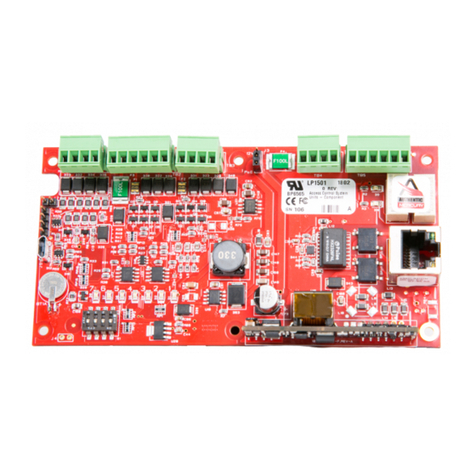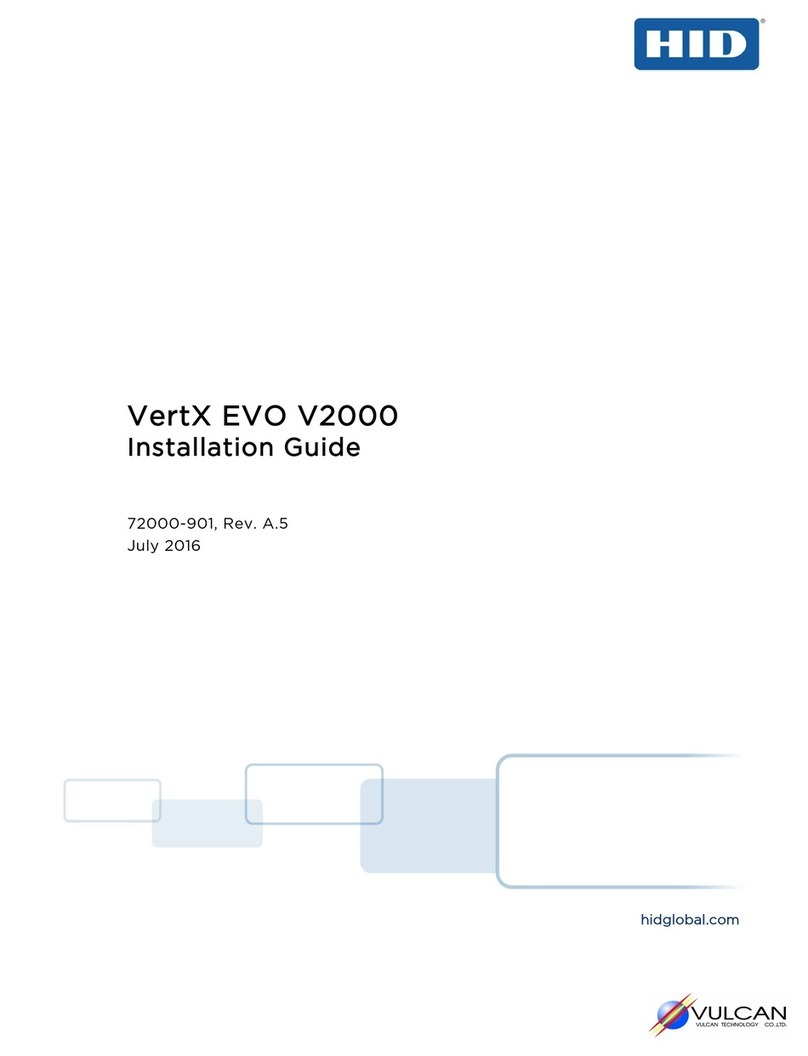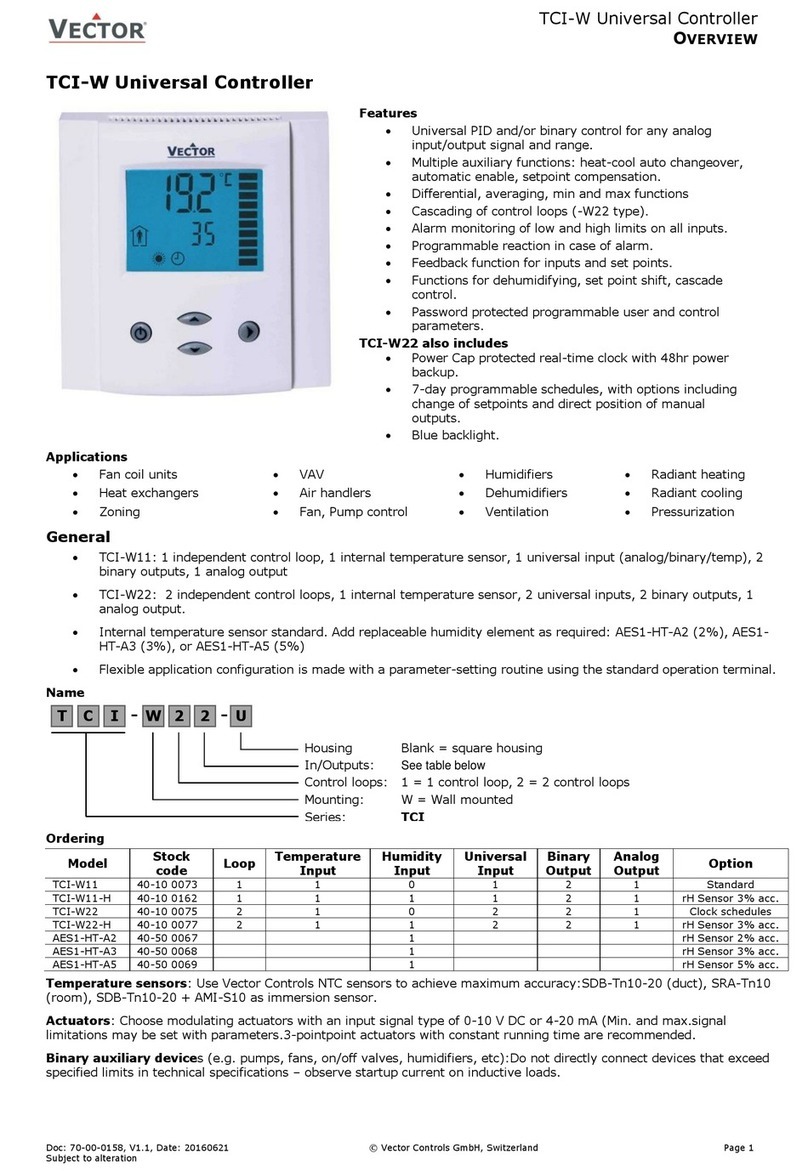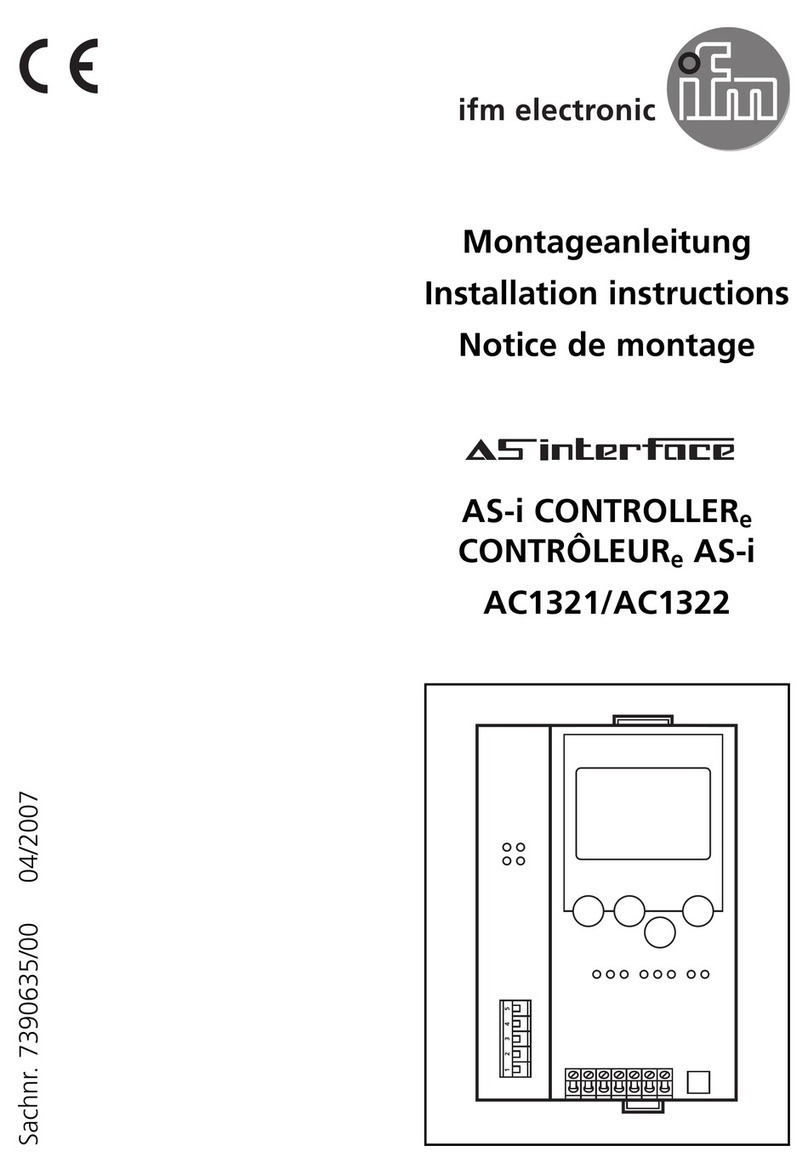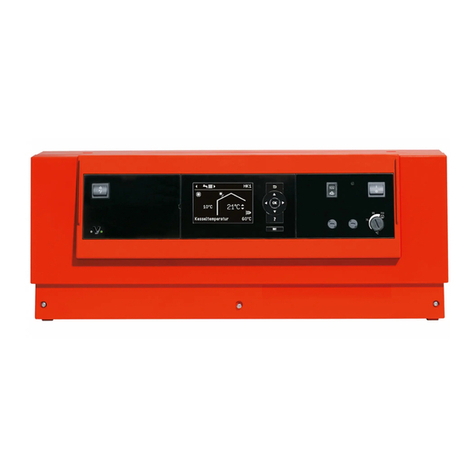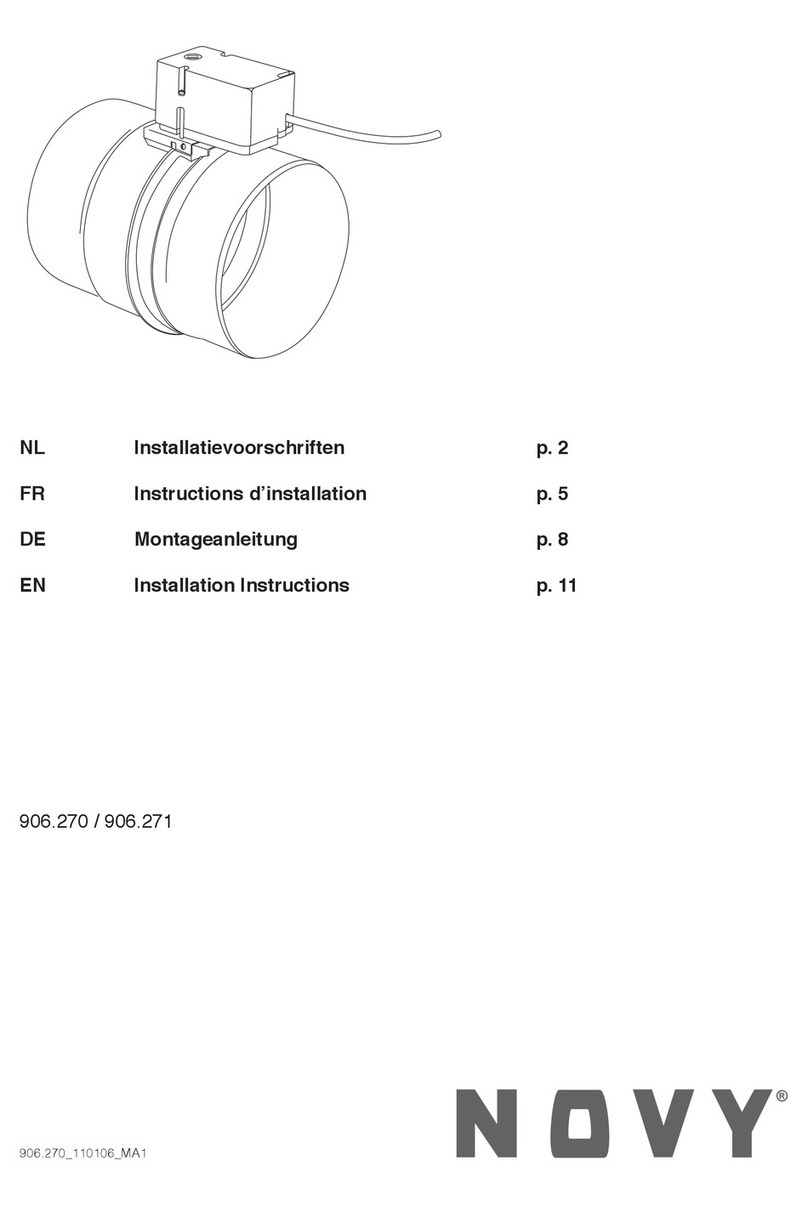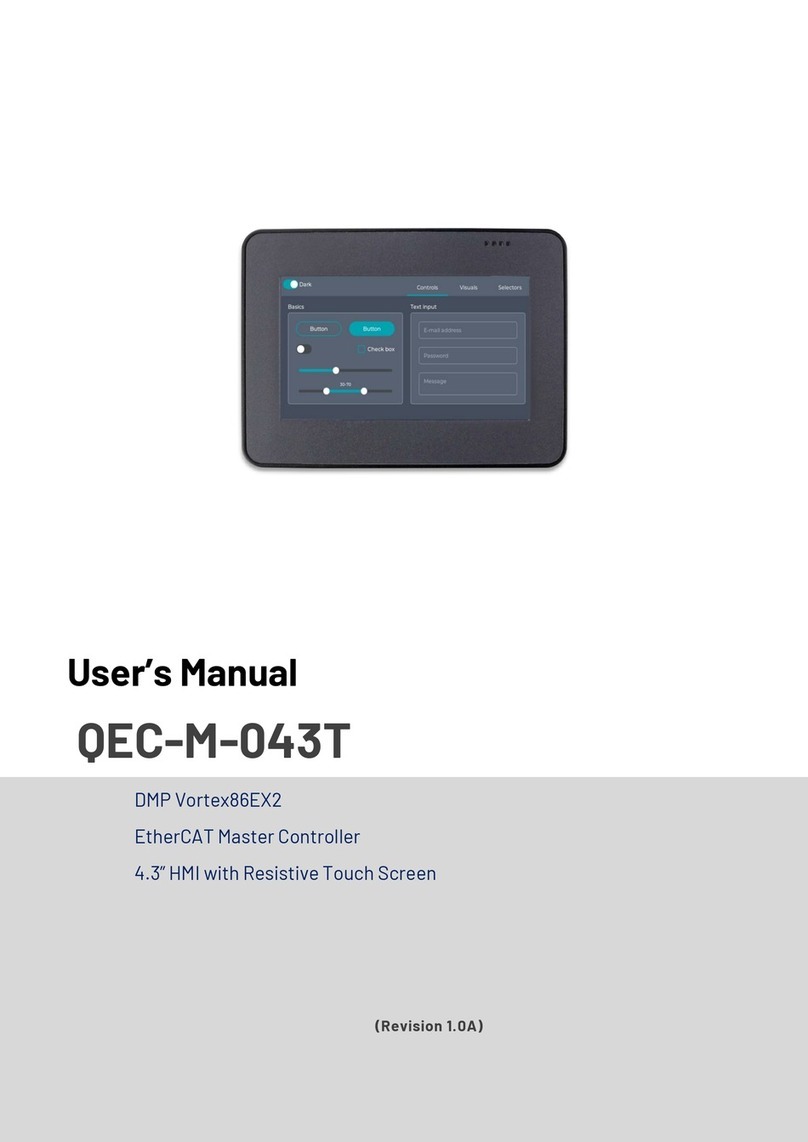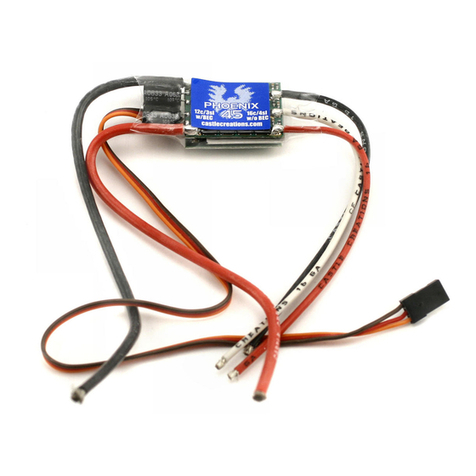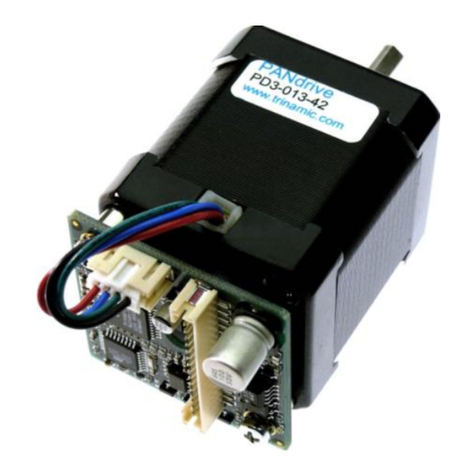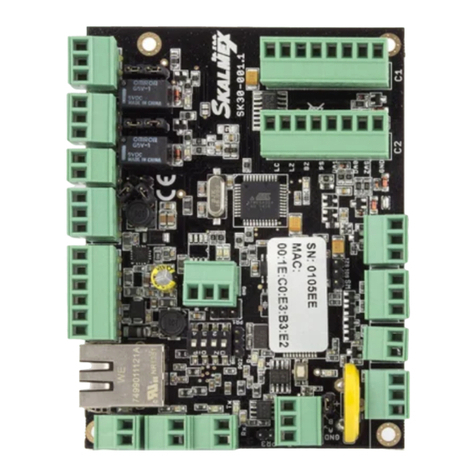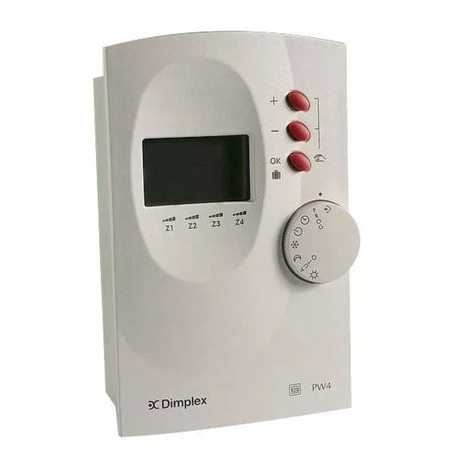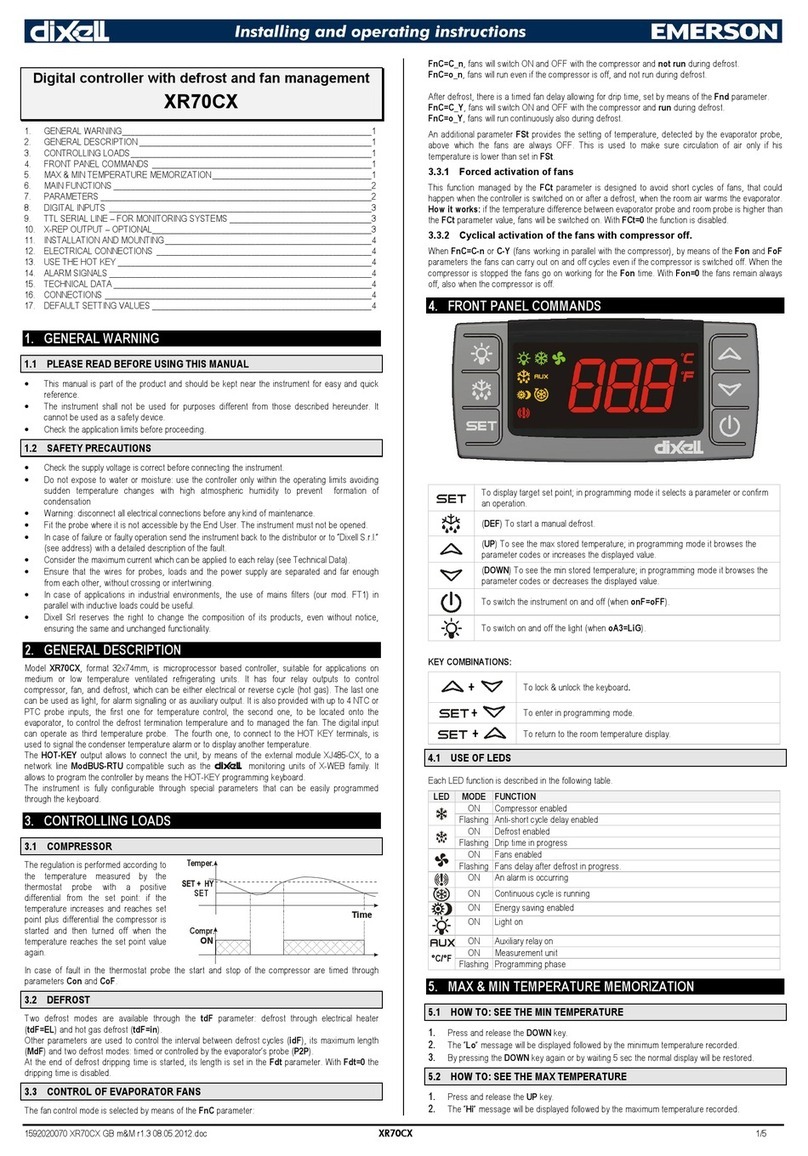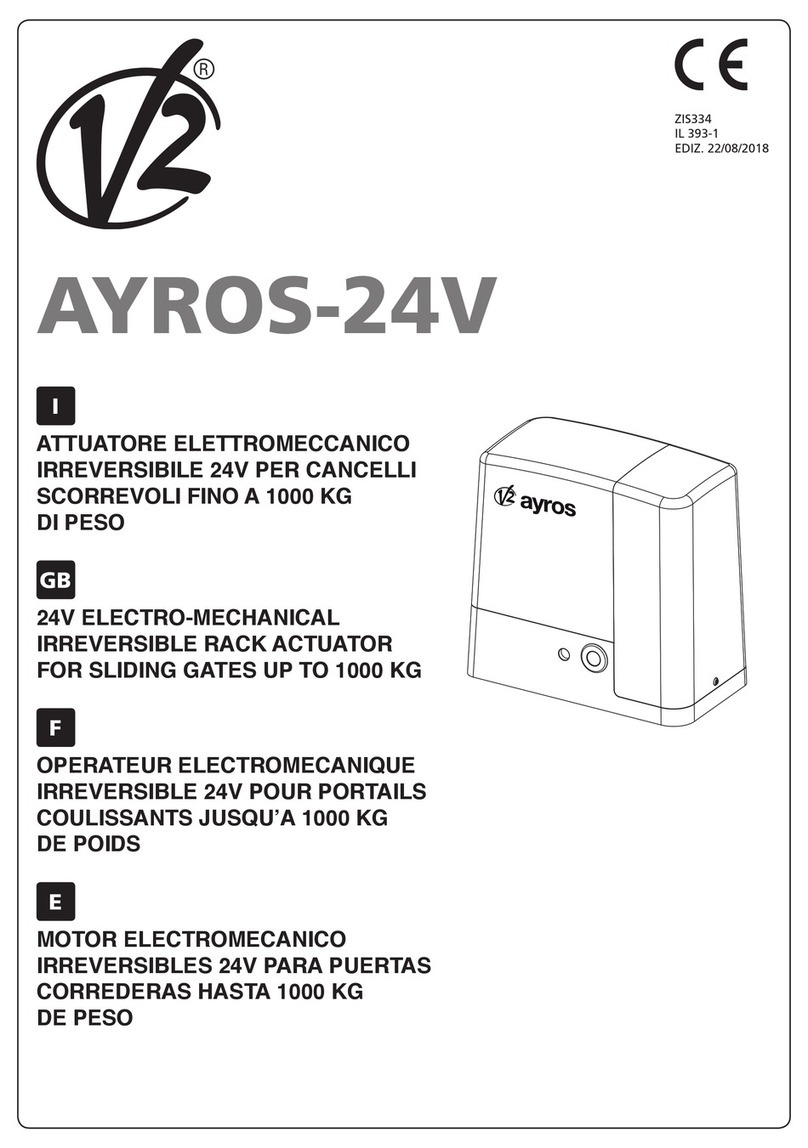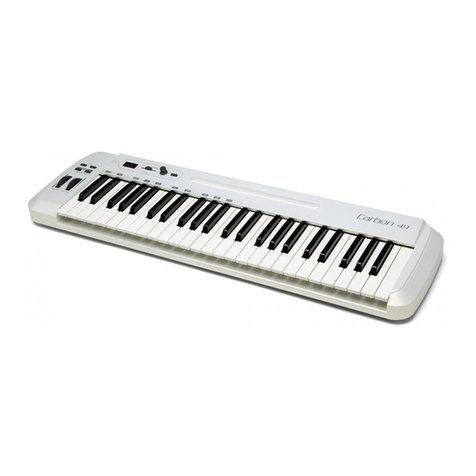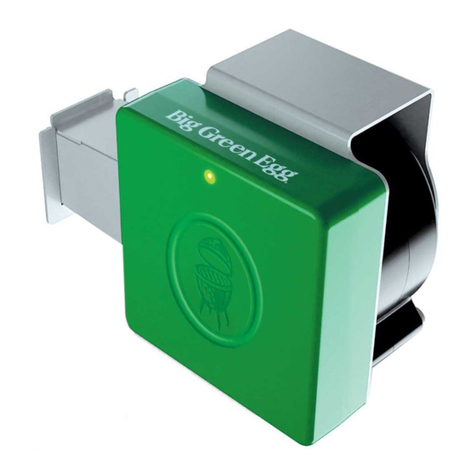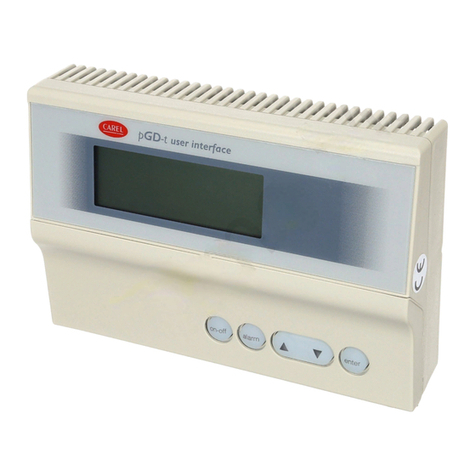HID EDGE EVO EH400 User manual

EDGE EVO is the next evolution in access control hardware solutions. A true IP solution that meets the demands of open architecture,
IP-centric environments, EDGE EVO provides fully distributed intelligence and decision making right to the door, leveraging the IT
infrastructure to the maximum extent possible. Wire the EDGE EVO device to Hi-O interface modules providing connectivity to electronic
door components and access control readers.
Hi-O involves devices with built-in intelligence and a CANbus that links all the devices together. Password protect or encrypt Hi-O CANbus
data trafc. Each Hi-O device (such as the push plate, electric strike, card reader and door operator) is connected to the CANbus by a
single, four-wire cable. Two of the wires supply power and the other two are used for data communication.
Specifications
CONDITIONS VOLTAGE DC (VDC) CURRENT
(Amp) Power (W) OPERATING
TEMPERTURE CABLE LENGTH UL REF
NUMBER
Input
DC Input (NSC)
+12 VDC 0.14 Amp 1.68
32° - 122°F
(0° - 50° C)
Hi-O CAN Bus Total Length 100 ft (30 m) -
22 AWG ● 0.65mm ● 0.33mm2
Maximum between drops 30 ft (10 m)
22 AWG ● 0.65mm ● 0.33mm2
RJ45 = 328 ft (100 m) - Category 5 K
E400CX1X2N
+24 VDC 0.08 Amp 1.92
PoE (+48VDC NOM) 0.05 Amp 2.40
DC Input (MAX)
+12 VDC 1.5 Amp 18.00
+24 VDC 1.5 Amp 36.00
PoE (+48 VDC NOM) 0.3 Amp 14.40
Output
CAN DC
Output
(MAX)
AUX 12 / 24 VDC Input +10.8 to +24 VDC 1.2 Amp* 28.80
PoE Input + 24 VDC (NOM) 0.4 Amp* 9.60
NSC = Normal Standby Condition
* Combined output ratings not to exceed V*I = W.
Values:
• 1.2 Amp (+24 VDC AUX Input, 28.80 W)
• 1.2 Amp (+12 VDC AUX Input, 12.46 W)
• 0.4 Amp (PoE Input, 9.6 W)
EDGE EVO®
Hi-O Networked Controller
EH400 / ESH400
InstallatIon GuIde
82000-920, Rev D.1
October 2012
© 2009 - 2012 HID Global Corporation. All rights reserved.
15370 Barranca Parkway
Irvine, CA 92618-2215
USA
X1 = K for Black
G for Gray
X2 = N for non-Solo
S for Solo

EDGE EVO Hi-O Networked Controller
EH400
82000-920, D.1
INSTALLATION GUIDE2©2009 - 2012 HID Global Corporation. All rights reserved.
Before starting installation, determine which components will be used in the system and analyze the power requirements to avoid
over-loading the EDGE EVO Hi-O Networked Controller (EH400).
The following steps illustrate sizing power requirements for the system.
Step 1 - Identify System Components
Identify the components that will be used in the system. A typical installation may include the following components:
• Door Position Switch – Detects when the door is open or closed.
• Magnetic Lock – Holds the door locked.
• Request to Exit (REX) Switch – Unlocks the door when exiting the secured area.
• Local Exit Alarm – Sounds an alarm upon an unauthorized exit.
• EDGE EVO Hi-O Edge Door Module (EDM-M) – Connects peripheral devices to the Hi-O bus.
• EDGE EVO Hi-O Networked Controller (EH400) – Provides access control and manages all peripherals
around the door.
• Hi-O iCLASS Wiegand Reader – Provides entry into the secured area.
Step 2 - Create System Layout
Using the components identied in “Step 1 - Identify System Components” on page 2, create the system layout.
In this example, the EH400 is connected to the remote server through an Ethernet connection and manages door
peripherals over the Hi-O bus. The EDM-M receives inputs from the Door Position Switch and REX Switch to drive the
Magnetic Lock and Local Exit Alarm outputs.
Unprotected
Area
Protected Area
Physical Access
Control Server
(real-time functions
not required)
Remote Area
CANbus Data
Ethernet Switch
Ethernet Data
Door Position
Switch
Magnetic Lock
REX Switch
Hi-O iCLASS
Reader
Door
Module
Local Sounder
Exit Alarm
Hi-O Networked
Controller
t
e
d
M
a
g
n
e
S
S
H
i-O
N
C
o
n
Figure 1 - System Layout Example
1Power Analysis

82000-920, D.1
INSTALLATION GUIDE 3
©2009 - 2012 HID Global Corporation. All rights reserved.
EDGE EVO Hi-O Networked Controller
EH400
Step 3 - Analyze Power Requirements
A - Door Peripheral Operational Currents
For the door peripherals identied in “Step 1 - Identify System Components” on page 2, consult the vendor data
sheets to determine the operational current draw. Typical operational current draw is provided below.
Note: See individual peripheral data sheets for actual operational current draw.
Device Conditions Typical Operational Current
Door Position Switch Vin = 12VDC 15mA
(For example, Securitron MSS) Vin = 24VDC 15mA
Mag Lock Vin = 12VDC 300mA
(For example, Securitron M32) Vin = 24VDC 150mA
REX Switch Vin = 12VDC 28mA
(For example, Securitron EEB) Vin = 24VDC 38mA
Exit Alarm
(For example, Detex 411)
Vin = 12VDC
Vin = 24VDC
70mA
70mA
iCLASS Wiegand Reader Vin = 12VDC 150mA
Consult HID datasheets for Hi-O enabled interface devices.
B - Match I/O Requirements to the Hi-O Interface Device
For the door peripherals identied in “Step 1 - Identify System Components” on page 2, the system requires
connection to a Hi-O interface device. In this example, the EDGE EVO Hi-O Edge Door Module (EDM-M) provides
general purpose I/O connectivity.
The Hi-O iCLASS reader does not require connection to the EDM-M and derives power and data connectivity from the
Hi-O CANbus directly.
Device Ports Conditions I out
EDGE EVO Hi-O Door
Module EDM-M
Strike / Aux
NC or NO
DC Output
+12VDC unregulated (@+12VDC EDM-M input) 700mA*
+24VDC unregulated (@+24VDC EDM-M input) 700mA*
+12VDC regulated (@+24VDC EDM-M input) 310 mA*
Dry Jumpers +12 to +24VDC External 2.00 Amp**
* Shared between each relay
** Each relay
The combined current requirement for the four door peripherals identied in “Step 1 - Identify System Components” on
page 2 is 413mA @ +12VDC,
or 273mA @ +24VDC.
The EDM-M provides sufcient power when the door peripherals are connected to the Strike/AUX relays congured for
unregulated output at +12VDC/+24VDC. Alternatively, connect the door peripherals to the Strike/AUX relays congured
for Dry contact.
The Hi-O iCLASS reader does not require connection to the EDM-M and derives power and data connectivity from the
Hi-O CANbus directly.

EDGE EVO Hi-O Networked Controller
EH400
82000-920, D.1
INSTALLATION GUIDE4©2009 - 2012 HID Global Corporation. All rights reserved.
C - Compute and Compare Overall Current Draw
Calculate the total current draw for all door peripherals, all Hi-O interface devices, and all Hi-O enabled readers with the
following equation, adding terms as required.
I total = I dps + I mag + I rex + I alarm + I Hi-O iCLASS reader + … + I EDM-M
For this example, the total current draw is shown.
I total @ +12VDC = 15mA + 300mA + 28mA + 70mA + 160mA* + 40mA* = 613mA
I total @ +24VDC = 15mA + 150mA + 38mA + 70mA + 160mA*+ 40mA* = 473mA
* Notes:
a. The EDM-M draws 40mA standby current.
b. The Hi-O iCLASS reader requires a +24VDC to +12VDC converter module (EDGE EVO Hi-O Voltage Module
- EVM), adding approximately 5 to 10mA for overall load requirements.
Compare the required current draw (I total) to the output current capacity of the EH400 (see “Specications” on page
1) to select the EH400 power scheme. The CAN DC PWR Output represents the entire power output capacity of the
EH400.
Device Port Conditions V out I out
Hi-O Networked Controller
(EH400)
CAN DC PWR
Output (MAX)
AUX +12/24 VDC Input +10.8 to
+24VDC 1.2Amp
PoE Input +24VDC (NOM) 400mA
In this example, the EH400 provides sufcient power when operating with +12/+24VDC auxiliary power supplies.
Directly connect the door peripherals identied in “Step 1 - Identify System Components” on page 2 to the I/O ports
of the EDGE EVO Hi-O Edge Door Module (EDM-M). Consult the EDM-M datasheet to determine the available current
capacity for the selected input power scheme of the EH400.
Ensure all door peripherals connected to the Strike/AUX relays and the Reader DC PWR Output or both do not exceed
1.2 Amps (AUX Input) or 400mA (PoE Input) combined. Alternatively, connect the door peripherals to the Strike/AUX
relays congured for Dry contact up to 2 Amps per relay.

82000-920, D.1
INSTALLATION GUIDE 5
©2009 - 2012 HID Global Corporation. All rights reserved.
EDGE EVO Hi-O Networked Controller
EH400
Step 4 - Select Power Scheme
Select the appropriate power scheme to meet overall current draw. Using the analysis from the previous sections equates to the
following power scheme possibilities.
Power Scheme Details
1Hi-O CANbus power derived from an external +12VDC or +24VDC power supply. The Hi-O Networked
Controller power is derived from PoE.
• Hi-O CANbus connections to the Hi-O Networked Controller shall omit the CANbus V+ and
CANbus GND output connections.
• Insert a voltage converter module between the CANBus and Hi-O iCLASS reader.
• Insert a UL294 Listed PoE Injector in the Ethernet line to power the Hi-O Networked Controller.
Unprotected
Area
Protected Area
Physical Access
Control Server
(real-time functions
not required)
Remote Area
CANbus Data
Ethernet Switch
Ethernet Data
Door Position
Switch
Magnetic Lock
REX Switch
Hi-O iCLASS
Reader
Door
Module
Local Sounder
Exit Alarm
Hi-O Networked
Controller
M
a
g
n
e
t
e
d
SS
H
i-
O
N
C
o
n
12 - 24VDC
Power Supply
Voltage Module
UL294 PoE
Injector
Ethernet Power

EDGE EVO Hi-O Networked Controller
EH400
82000-920, D.1
INSTALLATION GUIDE6©2009 - 2012 HID Global Corporation. All rights reserved.
2The Hi-O Networked Controller power is derived from an external +12VDC or +24VDC power supply.
• Hi-O CANbus connections to the Hi-O Networked Controller includes the CAN V+ and CAN GND
output connections.
• Insert a voltage converter module between the CANBus and Hi-O iCLASS reader.
• The Hi-O Networked Controller is connected directly to the Ethernet switch without a PoE injector.
Unprotected
Area
Protected Area
Physical Access
Control Server
(real-time functions
not required)
Remote Area
CANbus Data
Ethernet Switch
Ethernet Data
Door Position
Switch
Magnetic Lock
REX Switch
Hi-O iCLASS
Reader
Door
Module
Local Sounder
Exit Alarm
Hi-O Networked
Controller
t
e
d
M
a
g
n
e
S
S
H
i-O
N
C
o12 - 24VDC
Power Supply
Voltage
Module
CANbus Power
Mounting
Junction box not included.
2

82000-920, D.1
INSTALLATION GUIDE 7
©2009 - 2012 HID Global Corporation. All rights reserved.
EDGE EVO Hi-O Networked Controller
EH400
GND
+DC Input
Ethernet / PoE
Auto-Detected
CAN Termination
Resistor
(Default - Installed)
Activity LED
ES400, ER40 or ERP40 (Rear View)
Ethernet
Link LED
Hi-O CANbus
CAN_L
CAN_H
GND
CAN V+
Restore Network
Defaults Jumper
Wiring
3
ATTENTION
Observe precautions for handling
ELECTROSTATIC SENSITIVE DEVICES

EDGE EVO Hi-O Networked Controller
EH400
82000-920, D.1
INSTALLATION GUIDE8©2009 - 2012 HID Global Corporation. All rights reserved.
Install to Backplate
4
Contact EDGE EVO through one of the following methods.
Network Defaults Jumper
The Network Defaults Jumper requires physical access to the EDGE EVO controller. Physical access provides the necessity to
place a jumper over the debug port prior to the controller rebooting. The controller recongures the network settings to the factory
defaults when the jumper is on the debug port during a reboot. From this point, conguration (or re-conguration) proceeds
normally.
Use the Network Defaults Jumper to correct potential errors in an EDGE EVO controller Network Conguration or if the admin
password is forgotten.
A jumper is supplied with the EDGE EVO for the Hi-O termination; borrow this jumper to perform this process. Replace the
jumper to the Hi-O termination after restoring network defaults.
1. Remove the back plate on the EDGE EVO.
2. Loosen the Mylar cover.
3. Reboot the controller and place the supplied jumper over pins 3 and 5 of the Debug port after the beep. The Debug port
is an eight pin header, located above and to the right of the Ethernet connector, underneath the Mylar.
Note: The network reset opportunity occurs for 30 seconds, while rebooting the controller. On an EDGE EVO, a second
beep occurs to signal the end of the 30 second period.
4. After 30 seconds, the beeper stays on constantly to indicate success. When an error occurs, you receive a single beep.
5. Remove the jumper; return it to the Hi-O termination header and cycle power. The controller resets in approximately
60-seconds. Once the reset is complete, you hear the single beep. After the 30-second window, you hear the second
beep. The controller is fully functional during this time.
CAUTION: During the controller rebooting process, all network conguration information is overwritten and
returned to the original defaults.
6. Congure the controller for your installation parameters.
7. Reinstall the back plate of the EDGE EVO.

82000-920, D.1
INSTALLATION GUIDE 9
©2009 - 2012 HID Global Corporation. All rights reserved.
EDGE EVO Hi-O Networked Controller
EH400
Direct Connect
If connecting EDGE EVO to a network using static IP addressing or if the Discovery GUI is not installed on the PC, use this
method.
Note: The computer must be running Windows 2000 or XP and be congured for DHCP.
1. Disconnect the computer from the network and directly connect EDGE EVO to the computer with an Ethernet cable.
2. Click Start > Run. Enter ipcong /renew ↵
3. Access a web browser and enter 169.254.242.121 into the Address eld ↵
Discovery GUI (for DHCP networks)
With a DHCP network, use the HID Discovery GUI on the PC to locate and connect the Controller.
Note: The Controller must be connected to the network before power is applied for DHCP to function.
1. With the PC connected to the same network as the Controller, double-click hid-discovery.exe.
2. Select the device from the list.
3. Click Browser.
If the Discovery GUI is not on the PC, download the application from www.hidglobal.com/downloads/DiscoveryClient.zip.
Note: Java is required for the Discovery GUI.
The web browser will prompt for login information. From the Login screen enter admin, leaving the Password eld empty.
Follow the instructions on the web browser screen to congure EDGE EVO.
For EDGE EVO Solo, reference the EDGE EVO Solo User Guide, 83000-902, rev B.x.
Contact
5
Configure
6

EDGE EVO Hi-O Networked Controller
EH400
82000-920, D.1
INSTALLATION GUIDE10 ©2009 - 2012 HID Global Corporation. All rights reserved.
Power & Testing
7
Test the system once per year using the web Graphical User Interface to ensure all wiring and conguration is correct.
For additional installation information, such as PIR (Passive Infared Device) and other active Request-to-Exit (REX) devices, as
well as connecting re relays, see http://www.hidglobal.com/edgesupport.
Hi-O Interface Modules
Hi-O interface modules are used to interface the EDGE EVO device (Controller / Reader & Module or Network Controller) with
door electronic components. Components include access control readers, strike, magnetic lock, request to exit, door position
switch, and auxillary devices.
For Hi-O interface module wiring, see their respective Installation Guides.
Go to www.hidglobal.com > Support > Document Library.
Search the document type as a Installation Guide.
Model Description Part Number
EDM-M EDGE EVO Door Module 82342
EIM-M EDGE EVO Input Module 82340
EWM-M EDGE EVO Reader Module 82360
EDWM-M EDGE EVO Door & Reader Module 82363AM
ELM EDGE EVO Lock Module 82301
EVM EDGE EVO Voltage Module 82365
Glossary
Acronym Description Acronym Description
AC Fail AC Power Failure Input Sense GND Ground
AUX Auxillary Input or Output GRN LED Green LED Output
BATT Fail Battery Failure Input Sense GRP SEL Group Select
CAN_H Hi-O CANbus High NC Normally Closed
CAN_L Hi-O CANbus Low NO Normally Open
CLK Clock PIR Passive Infared device
COM Common PoE Power over Ethernet
Data0 Wiegand Data 0 Input RED LED Red LED Output
Data1 Wiegand Data 1 Input REX Request-to-Exit Input
Door Mon Door Monitor Input RLY Relay
DS Door Strike

82000-920, D.1
INSTALLATION GUIDE 11
©2009 - 2012 HID Global Corporation. All rights reserved.
EDGE EVO Hi-O Networked Controller
EH400
Intentional Blank

Regulatory
UL
Connect only to a Listed Access Control / Burglary power-limited power supply, or Listed Access Control / Burglary PoE (Power-over-Ethernet) adapter.
All National and local Electrical codes apply. Install in accordance with NFPA70 (NEC), Local Codes, and authorities having jurisdiction. Host-based security, Ethernet / Host Communication, has not been
evaluated by UL. Ethernet port has been evaluated for supplemental use only.
Indoor use only.
The EDGE EVO family has been evaluated for standalone Access Control.
Mount onto UL Listed Single-Gang electrical box.
Hi-O Networked Controller and EDGE EVO Modules are UL Listed for installation within the protected area.
All panic and alarm hardware and equipment shall be UL Listed.
All cabling and wire shall be UL Listed or Recognized and suitable for the application.
All splices and connections shall be mechanically secure and bonded electrically.
EDGE EVO was evaluated for use with all Listed HID Global Wiegand models: iCLASS, Indala Prox, HID Prox, bioCLASS, SmartID, SmartTRANS, and Mag Stripe series (with and without keypad), up to 128-
bit formats. EDGE EVO was evaluated for use with all HID Global Hi-O iCLASS readers.
Hi-O Networked Controller is UL Listed for installation in the unprotected area, as well as within the protected area.
CAUTION: Any changes or modifcations to this devise not explicitly approved by the manufacturer could void your authority to operate this equipment.
FCC
This device complies with part 15 of the FCC Rules. Operation is subject to the following two conditions: (1) This device may not cause harmful interference, and (2) this device must
accept any interference received, including interference that may cause undesired operation.
Canada Radio Certification
This device complies with Industry Canada license-exempt RSS standard(s). Operation is subject to the following two conditions: (1) this device may not cause interference, and (2) this
device must accept any interference, including interference that may cause undesired operation of the device.
Le présent appareil est conforme aux CNR d’Industrie Canada applicables aux appareils radio exempts de licence. L’exploitation est autorisée aux deux conditions suivantes : (1)
l’appareil ne doit pas produire de brouillage, et (2) l’utilisateur de l’appareil doit accepter tout brouillage radioélectrique subi, même si le brouillage est susceptible d’en compromettre le
fonctionnement.
CE MARKING
HID Global hereby declares that these proximity readers are in compliance with the essential requirements and other relevant provisions of Directive 1999/5/EC.
Por el presente, HID Global declara que estos lectores de proximidad cumplen con los requisitos esenciales y otras disposiciones relevantes de la Directiva 1999/5/EC.
HID Global déclare par la présente que ces lecteurs à proximité sont conformes aux exigences essentielles et aux autres stipulations pertinentes de la Directive 1999/5/CE.
A HID Global, por meio deste, declara que estes leitores de proximidade estão em conformidade com as exigências essenciais e outras condições da diretiva 1999/5/EC.
HID Global bestätigt hiermit, dass die Leser die wesentlichen Anforderungen und anderen relevanten Bestimmungen der Richtlinie 1999/5/EG erfüllen.
HID Global dichiara che i lettori di prossimità sono conformi ai requisiti essenziali e ad altre misure rilevanti come previsto dalla Direttiva europea 1999/5/EC.
Download copies of the R&TTE Declaration of Conformity (DoC) at http://certications.hidglobal.com.
JAPAN MIC
この装置は認証済みです。
TAIWAN NCC
經型式認證合格之低功率射頻電機,非經許可,公司、商號或使用者均不得擅自變更頻率、加大功率或變更原設計之特性及功能。低功率射頻電機之使用不得
影響飛航安全及干擾合法通信;經發現有干擾現象時,應立即停用,並改善至無干擾時方得繼續使用。前項合法通信,指依電信法規定作業之無線電通信。低功
率射頻電機須忍受合法通信或工業、科學及醫療用電波輻射性電機設備之干擾。
According to «Administrative Regulations on Low Power Radio Waves Radiated Devices» without permission granted by the NCC, any company, enterprise, or user is not allowed to change
frequency, enhance transmitting power or alter original characteristic as well as performance to an approved low power radio-frequency devices. The low power radio-frequency devices shall
not inuence aircraft security and interfere legal communications; If found, the user shall cease operating immediately until no interference is achieved. The said legal communications means
radio communications is operated in compliance with the Telecommunications Act.
The low power radio-frequency devices must be susceptible with the interference from legal communications or ISM radio wave radiated devices.
This product includes software developed by the OpenSSL Project for use in the OpenSSL Toolkit (http://www.openssl.org/).
This product includes cryptographic software written by Eric Young ([email protected]).
hidglobal.com
ACCESS experience.
North America
15370 Barranca Parkway
Irvine, CA 92618
USA
Phone: 800 237 7769
Fax: 949 732 2120
Asia Pacific
19/F 625 King’s Road
NorthPoint, Island East
Hong Kong
Phone: 852 3160 9800
Fax: 852 3160 4809
Europe, Middle East & Africa
Phoenix Road
Haverhill, Suolk CB9 7AE
England
Phone: +44 1440 714 850
Fax: +44 1440 714 840
HID Global
support.hidglobal.com
© 2009 - 2012 HID Global Corporation. All rights reserved. 82000-920, Rev D.1
Patent Pending
Check reader label for current regulatory approvals.
HID GLOBAL, HID, the HID logo, EDGE EVO and Hi-O are the trademarks or registered
trademarks of HID Global Corporation, or its licensors, in the U.S. and other countries.
This manual suits for next models
1
Table of contents
Other HID Controllers manuals
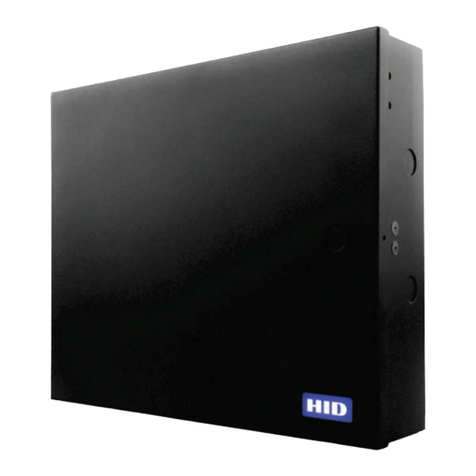
HID
HID ACW2-XN User manual
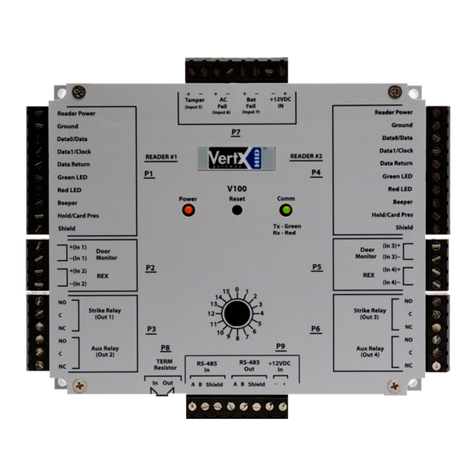
HID
HID Vertx CS V100 User manual
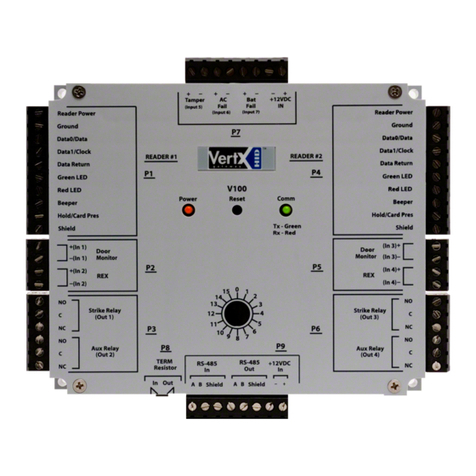
HID
HID VertX EVO Series User manual

HID
HID VertX EVO V1000 User manual
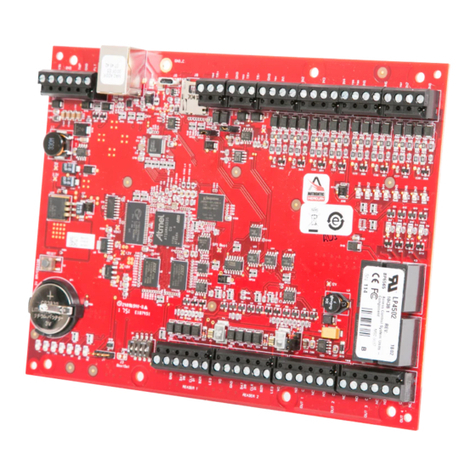
HID
HID Mercury LP4502 User manual
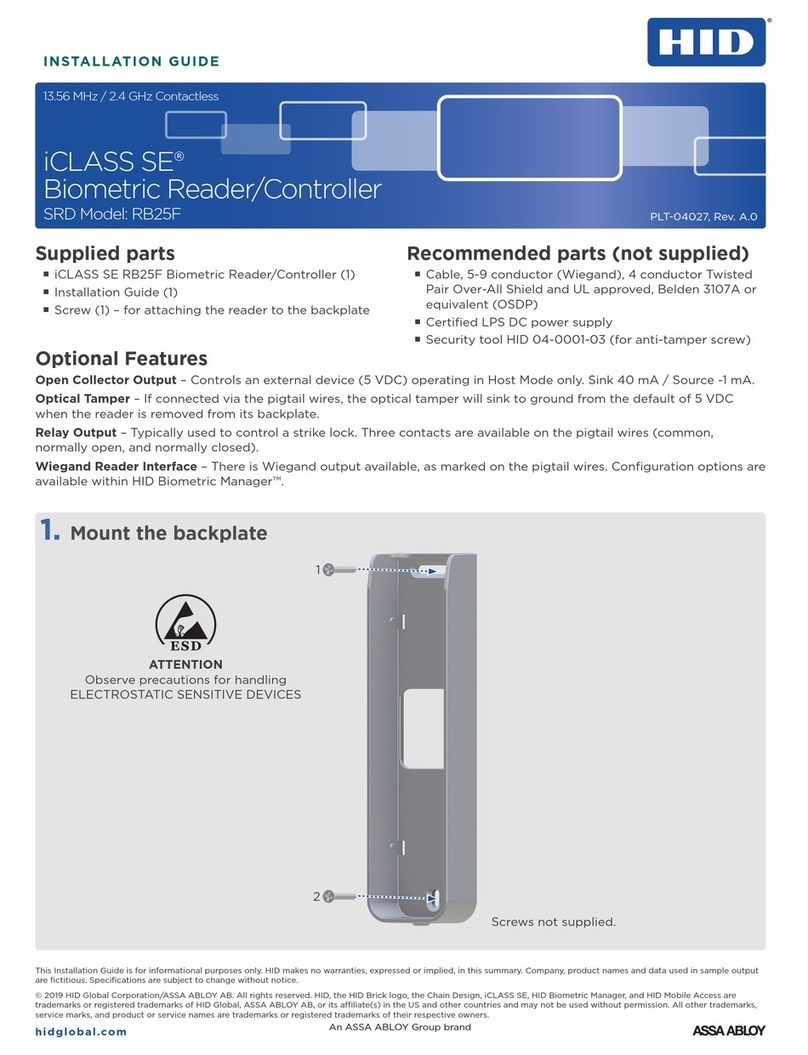
HID
HID iCLASS SE RB25F User manual
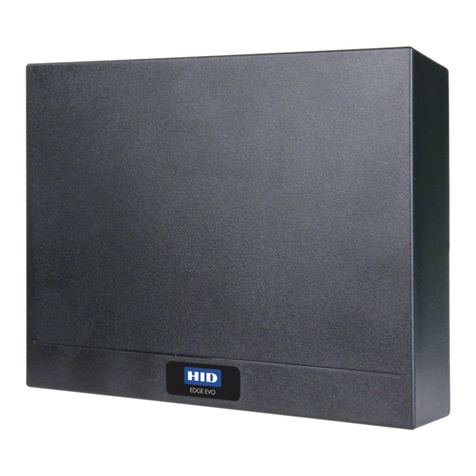
HID
HID EDGE EVO EH400-K User manual
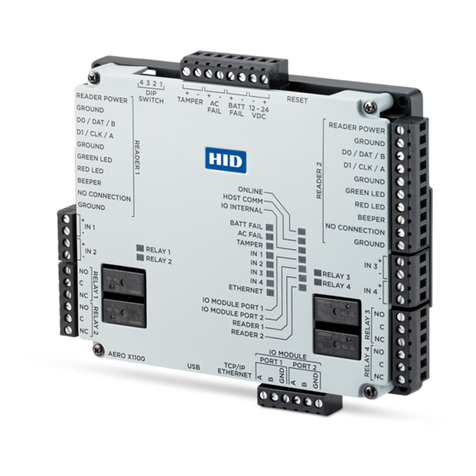
HID
HID Aero X1100 User manual
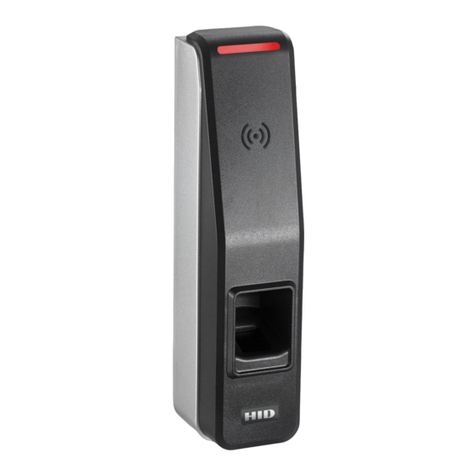
HID
HID Signo 25B User manual
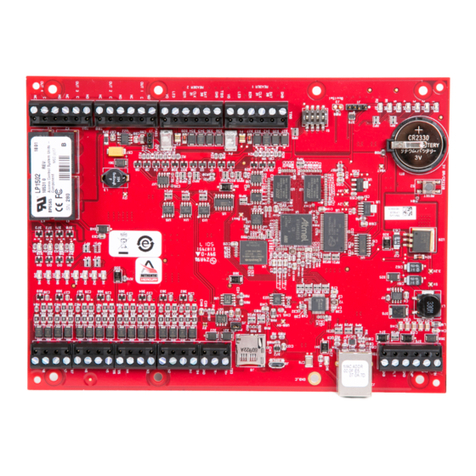
HID
HID Mercury LP1502 User manual
